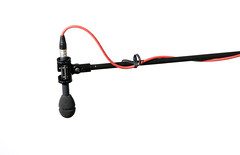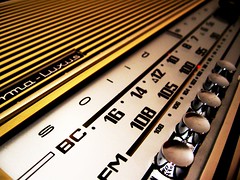Organising podcasts
April 16, 2013 in digital music by Dan Gravell

In the most part, this blog concentrates on musical releases and how to organise them in your computer audio collection. But music isn't the only form of audio. Podcasts are audio files, often spoken word, which are episodic and released periodically. It is possible to download them and include them within your wider music collection.
And, just like the rest of your audio, the time comes when you want to organise these files to make them most browseable, searchable and navigable.
There are three main aspects of podcats that I need to assess before I consider a set of podcast files 'organised':
- Tagging; the Three Cs (completeness, correctness, consistency) of internal tags
- Cover art
- File locations
Tagging
Choosing the correct metadata to populate inside podcast files is the first task to consider, and is also the most involved. These identification and classification tags provide the basis for further organising and browsing. They are what is shown when you scroll through your podcast episodes in your favourite music player. So it's best to start by considering how the most fundamental tags, those that will be supported by most music players and form the default views in most music player user interfaces, should be populated. These tags are:
- "Album" name
- "Artist" name
- "Track" name
- "Track" number, or position
- Year
- Genre
I've surrounded some of these tags with quotes. It's when podcasts are considered that you realise the standard ways of referring to these metadata is very specific to music (popular, contemporary Western music at that). As part of considering best practice to podcast tagging, we need to consider how the granularity of musical release structure (release/album, tracks, artists) map to podcasts.
Albums, tracks, podcasts and episodes

Western contemporary music releases tend to have a fairly standard two level structure: a release contains a number of tracks. In terms of physical releases there is also sometimes the denotation of media (e.g. disc II, side B and so on).
Podcasts have more of a two/three layer structure: podcast name, series (sometimes), and episode. Your resulting tagging depends on how important separating series is. If it is important, you could follow a similar approach to that suggested for classical releases. In addition, in some cases, there might be an integer denoting the position of the episode within the series or podcast, and sometimes not. Many podcasts simply use the date of original release or broadcast to order episodes by.
This is a pure, normalised way of storing the data, but there are two disadvantages. First, it's more work to separate the data and populate differently depending on the file type. You will be well within the bowels of your music tagger's 'advanced view' here. Secondly, support from your music player is also less likely. Don't forget you need to adopt the lowest common denominator for all of your music players.
Instead, the approach I use is to store the series name (if it exists) within the track (episode) name, and just store the podcast name inside the "Album" tag. This gives the benefit of finding the podcast via the podcast title fairly easy, as there's just one instance of each podcast title. Here's how the episodes end up being titled:
| "Album" name | "Track" name |
|---|---|
| The Game Podcast | 2012/2013 - Week 35 - Everton are the best club in Liverpool |
| The Game Podcast | 2012/2013 - Week 34 - Champions League race wide open |
| In Our Time With Melvyn Bragg | Lysenko |
| In Our Time With Melvyn Bragg | The Riddle of the Sands |
For The Game Podcast, a weekly podcast about football, the season and order is important so I include the football season at the start of the episode name, followed by the given week. For In Our Time the ordering is not so important, and neither is it emphasised on the official website, so I leave it out. I can always get an approximate ordering using the year tag.
Other tags
Most other tags are fairly self describing. I find it best to tag genres as "podcast" or similar. One could develop further possibilities, separating into news, history, sport etc, but for me this is fine.
I think it's also useful to have the date of release or broadcast populated, or at least the year.
Cover art

In most cases, the cover art will be provided embedded into the audio files themselves. If this isn't the case, here are a couple of suggestions for finding the art...
You can, of course, use bliss. bliss is unlikely to find podcasts using its automatic search, which is more tuned for musical releases. However, the change art screen does search Google and may well find the artwork.
If you don't want to use bliss, you can use Google manually. Here's an example Google query to find images for a given podcast:
site:itunes.apple.com "startups for the rest of us"
This gives a set of results for the Startups For The Rest Of Us podcast, just those that appear in the iTunes store. The first result (currently) is the podcast image, so you can use bliss to install that image into all episodes for that podcast using its Change art page. Within the Change art page, copy and paste the URL or download the image, then upload it to bliss.
You can, of course, remove the site:itunes.apple.com to search the rest of the (Google indexed) Web. Not all podcasts are in the iTunes store, but most of the popular ones are.
In most cases you should always be embedding artwork. It's worth it to save a folder.jpg or cover.jpg too, particularly the former if you are a Windows user (this makes Windows Explorer show the artwork as the icon for this folder). Obviously, if all episodes for a podcast are in the same folder but the artwork changes from series to series, you may have to split the folders to represent this.
File locations
The importance of file locations depends on how often you need to find your podcasts in your file system. If you often copy files, e.g. to synchronise with your mobile MP3 or smartphone, it can be quite useful to keep your podcast files in a consistent location.
The most important rule here that applies to all podcasts is that episodes for a given podcast should be kept together. So long as they are stored together, once you have found the episodes you have done searching. If your "Album" tags are kept the same, as suggested above, a tool like bliss can help consolidate all of your file paths.
There are other possibilities. It might be worth storing all of your podcasts under a common podcasts folder to stop cluttering of the root music folder. If you often copy the latest podcasts from folder to smartphone, say, you might find this the easiest way of finding a given podcasts' episodes in your music folder.
I hope this gives you some good ideas on ways to start organising your podcasts. If you have other rules or suggestions let me know in the comments below!
Thanks to ralphbijker, C.P.Storm and Shazeen Samad for the image above.

